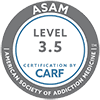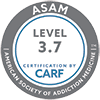 Once someone makes the decision to enter a treatment facility for drug or alcohol addiction, it may seem like the hard part is over.
Once someone makes the decision to enter a treatment facility for drug or alcohol addiction, it may seem like the hard part is over.
Without a doubt, taking that first step is critical to changing behavior and accepting that a new, healthier way of living is possible.
The next major decision is actually even more critical to long-term wellness: how long to stay in rehab? While we’re all conditioned to want the quick, easy, and relatively painless solution to any problem, shortchanging addiction recovery isn’t advisable. It’s important to understand that each person will face unique challenges, and why a longer stay allows for greater recovery success.
Each Treatment Is Individualized
A residential facility has a structure in place for providing the best treatment for drug or alcohol addiction. So the first answer to “How long does rehab take?” is: as long as it takes. This usually isn’t the answer someone with addiction—or their loved ones—want to hear.
But keep in mind: alcohol or drug addiction develops over months or years. Consequently, it’ll take considerable time for someone to progress through the following:
- Detox from harmful substances, which may require medical assistance
- Determine the root causes of addiction
- Identify and treat other underlying conditions, such as mental health issues, trauma, and abuse
- Reduce external stressors while in a safe environment to focus on healing
- Learn to recognize key triggers and implement coping mechanisms
- Examine life choices regarding employment, education, relationships, and life direction
- Accept and develop new behaviors not centered on patterns of addiction
These aren’t the only factors someone in treatment may have to deal with, but they demonstrate why individualized treatment takes time to administer. This is the approach that works best for long-term wellness.
Typical Lengths of Treatment
On average, participants in a drug or alcohol rehab program start with a 30-day program. However, the National Institute on Drug Abuse indicates that residential or outpatient treatment lasting less than 90 days is “of limited effectiveness.”
Treatment that goes beyond 90 days increases the likelihood of “positive outcomes,” including minimizing treatment dropout so a person doesn’t experience a relapse. So aspects of effective change, including improving the motivation to achieve recovery, happen with a longer duration of care.
Once again, length of treatment depends on the individual’s dedication to healing, the condition at the time of facility entry, and the type of substance. For example, if someone is addicted to opiates, they often receive medically-supervised maintenance care to reduce withdrawal symptoms and dependency. Controlled monitoring, root-cause treatment, and behavioral changes may take up to a year or more of application before someone is healthy again.
Understanding the Continuum of Care
Entering a residential rehabilitation facility for 90 days or more is the vital first step toward solid recovery. However, to achieve full wellness, a participant must work through other steps of addiction treatment, sometimes referred to as the continuum of care.
- Clients may need outpatient care and counseling that lasts for six months or longer after they leave a facility.
- Gaining support for treatment from family members and friends on a continual basis is crucial during and after rehab care.
- Taking time to address important issues and conditions and use the proper tools to handle the resulting emotions and consequences stem from a foundation built in long-term treatment.
Some individuals may also be able to move toward eventual wellness by leaving a facility and moving to a sober living house. This environment is designed to allow for more independence while still providing the necessary structure and guidance for continued recovery. To thrive in a sober living house requires additional motivation and a commitment to sobriety, but many people appreciate the ability to assimilate into everyday life gradually, and usually transition into this type of facility for another 90 days or even longer.
The bottom line is this: when people dedicate the time and resources to a treatment program, they have a greater opportunity to successfully change their lives for the better. While work or family obligations may initially make it difficult to commit to a 90-day or longer program, there’s the benefit of achieving true wellness and acquiring tools to be healthy for a lifetime.
Other Sources:
National Institute on Alcohol Abuse and Alcoholism.
NAADAC



